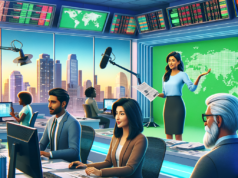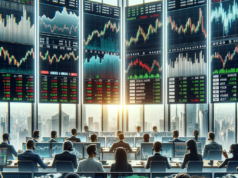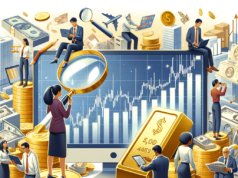
As the world grapples with unprecedented challenges and opportunities, economic forecasts are becoming increasingly vital for investors, policymakers, and businesses alike. The interplay of technology, demographic shifts, climate change, and geopolitical tensions is reshaping the economic landscape in ways that could have profound implications for markets. This article delves into the current economic indicators, technological influences, demographic changes, climate-related risks, geopolitical dynamics, and strategies for navigating the uncertainties ahead.
Understanding the Current Economic Landscape: Key Indicators and Trends
The current economic landscape is characterized by a complex interplay of various indicators that signal both growth and potential downturns. Key metrics such as GDP growth rates, unemployment figures, inflation rates, and consumer confidence indices provide a snapshot of economic health. Recent trends indicate a mixed recovery from the pandemic-induced recession, with some sectors rebounding robustly while others struggle to regain momentum. Inflation remains a significant concern, driven by supply chain disruptions and increased consumer demand. Central banks are faced with the challenge of balancing interest rates to curb inflation without stifling growth, creating an environment of uncertainty for investors and businesses alike.
The Role of Technology in Shaping Future Economic Predictions
Technology is increasingly becoming a cornerstone of economic forecasting, offering tools and methodologies that enhance predictive accuracy. The rise of big data analytics, artificial intelligence, and machine learning has transformed how economists analyze trends and make predictions. These technologies enable the processing of vast amounts of data, allowing for real-time insights into consumer behavior, market trends, and economic indicators. Furthermore, the digital transformation of industries is creating new markets and opportunities, particularly in sectors such as e-commerce, fintech, and renewable energy. As technology continues to evolve, its role in shaping economic forecasts will become even more critical, potentially leading to more agile and responsive market strategies.
Demographic Shifts: How Population Changes Impact Market Dynamics
Demographic changes are reshaping market dynamics in profound ways, influencing everything from consumer preferences to labor market trends. The aging population in developed countries presents both challenges and opportunities, as businesses must adapt to cater to older consumers while also addressing potential labor shortages. Conversely, emerging markets are experiencing youthful populations that drive demand for technology and innovation. Additionally, urbanization trends are leading to increased concentration of economic activity in cities, prompting shifts in real estate, infrastructure, and service industries. Understanding these demographic shifts is essential for investors seeking to capitalize on emerging trends and align their strategies with evolving consumer needs.
Climate Change and Its Economic Implications: A Forecast for Investors
Climate change poses significant economic implications that investors cannot afford to overlook. As the frequency and severity of climate-related events increase, businesses face heightened risks, including supply chain disruptions, regulatory changes, and shifts in consumer preferences toward sustainable products. The transition to a low-carbon economy is creating new investment opportunities in renewable energy, electric vehicles, and sustainable agriculture. However, the potential for stranded assets in fossil fuel industries and the financial risks associated with climate-related disasters necessitate a thorough assessment of investment portfolios. Investors who proactively integrate climate considerations into their strategies will be better positioned to navigate the evolving economic landscape.
Geopolitical Tensions: Assessing Risks and Opportunities in Global Markets
Geopolitical tensions are a significant factor influencing global markets, with implications for trade, investment, and economic stability. Ongoing conflicts, trade wars, and diplomatic disputes can lead to market volatility and uncertainty, impacting investor confidence. However, these tensions also present opportunities for investors willing to adapt to changing circumstances. For instance, supply chain diversification and the reshoring of manufacturing can create new investment avenues in domestic industries. Additionally, emerging markets may offer growth potential as they navigate geopolitical challenges. A nuanced understanding of geopolitical dynamics is essential for investors seeking to identify both risks and opportunities in an increasingly interconnected world.
Preparing for the Unexpected: Strategies for Navigating Economic Uncertainty
In an era marked by rapid change and uncertainty, developing robust strategies for navigating economic fluctuations is crucial for investors and businesses. Diversification remains a fundamental principle, allowing portfolios to withstand market volatility by spreading risk across various asset classes and geographies. Additionally, maintaining liquidity can provide the flexibility needed to capitalize on emerging opportunities or weather economic downturns. Staying informed about macroeconomic trends, technological advancements, and geopolitical developments is equally important, enabling stakeholders to make data-driven decisions. Finally, fostering resilience through adaptive business models and innovative practices will be key to thriving in an unpredictable economic environment.
As we look to the future, the economic landscape is poised for transformation driven by technology, demographic shifts, climate change, and geopolitical dynamics. Understanding these factors and their implications will be essential for investors and businesses aiming to navigate the complexities of the global economy. By embracing adaptability and strategic foresight, stakeholders can position themselves to not only survive but thrive in the face of uncertainty, ultimately reshaping markets for years to come.





























